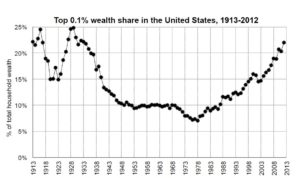Scary numbers
David Ruccio

Gabriel Zucman, in his article in the special issue of Pathways, “State of the Union: The Poverty and Inequality Report 2016” [1], reveals lots of scary numbers about wealth inequality in the United States.* The scariest is the percentage of wealth owned by the top 0.1 percent of households, which “has exploded in the U.S. over the past four decades.”
The share of wealth held by the top 0.1 percent of households is now almost as high as in the late 1920s, when The Great Gatsby defined an era that rested on the inherited fortunes of the robber barons of the Gilded Age.
In recent decades, only a tiny fraction of the population saw its wealth share grow. While the wealth share of the top 0.1 percent increased a lot in recent decades, that of the next 0.9 percent (i.e., 99–99.9) did not. And the share of total wealth of the “merely rich”– house- holds who fall in the top 10 percent, but are not wealthy enough to be counted among the top 1 percent – actually declined slightly over the past four decades. In other words, $20 million fortunes (and higher) grew much faster than smaller fortunes in the single-digit millions.
The flip side of this trend is, of course, the wealth of the bottom 90 percent, which actually grew from 15 percent in the 1920s to 36 percent in the 1980s but dramatically declined thereafter.
According to the most recent data, the members of the bottom 90 percent collectively own just 23 percent of total U.S. wealth, about as much as in 1940.
Yes, indeed, these are scary numbers.
*There are lots of other scary numbers in the rest of the report, concerning U.S. poverty, income inequality, and much else – alone and in comparison to other countries.
1. http://inequality.stanford.edu/sites/default/files/Pathways-SOTU-2016.pdf
Source: Real World Econ Review blog, 6 Nov 2016
https://rwer.wordpress.com/2016/11/06/26530/



























